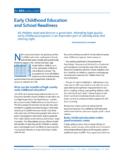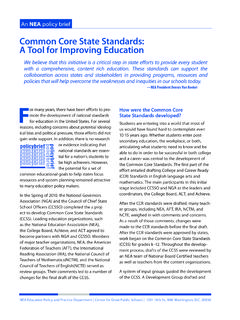Transcription of Parent, Family, Community Involvement in Education
1 NEA Education Policy and Practice Department | Center for Great public Schools | 1201 16th St., NW, Washington, 20036 An NEA policy brief It takes a village to raise a child is a popular proverb with a clear message: the whole Community has an essential role to play in the growth and development of its young people. In addition to the vital role that parents and family members play in a child s Education , the broader commu-nity too has a responsibility to assure high-quality Education for all the past, parent Involvement was characterized by volunteers, mostly mothers, assisting in the classroom, chaperoning students, and fundraising.
2 Today, the old model has been replaced with a much more inclusive approach: school -family- Community partnerships now include mothers and fathers, stepparents, grandpar-ents, foster parents, other relatives and caregivers, busi-ness leaders and Community groups all participating in goal-oriented activities, at all grade levels, linked to student achievement and school success. The research is clear, consistent, and convincingParent, family, and Community Involvement in educa-tion correlates with higher academic performance and school improvement.
3 When schools, parents, families, and communities work together to support learning, students tend to earn higher grades, attend school more regularly, stay in school longer, and enroll in higher level programs. Researchers cite parent-family- Community Involvement as a key to addressing the school dropout crisis1 and note that strong school -fami-ly- Community partnerships foster higher educational aspirations and more motivated The evi-dence holds true for students at both the elementary and secondary level, regardless of the parent s educa-tion, family income.
4 Or background and the research shows parent Involvement affects minority students academic achievement across all teaching and learning requires addressing students social service needs, as well as their academic ones, and this broad-based support is essential to clos-ing achievement gaps. The positive impact of connect-ing Community resources with student needs is well In fact, Community support of the educa-tional process is considered one of the characteristics common to high-performing do parents, families, and communities get involved?
5 Parent, family, and Community Involvement means dif-ferent things to different people. A research-based framework,6 developed by Joyce Epstein of Johns Hop-kins University, describes six types of Involvement parenting, communicating, volunteering, learning at home, decision making, and collaborating with the Community that offer a broad range of school , family, and Community activities that can engage all parties and help meet student needs. Successful school -parent- Community partnerships are not stand-alone projects or add-on programs but are well integrated with the school s overall mission and goals.
6 Research and field-work show that parent- school -partnerships improve schools, strengthen families, build Community support, and increase student achievement and press for more partnershipsData compiled in 20057 show that 17 states have directed all districts or schools to implement parental Involvement policies. Seven states Alaska, California, Indiana, Minnesota, Nevada, South Carolina, and Tex-as have obligated schools or districts to develop poli-cies linking parent- Community partnerships to school improvement plans, and in Delaware, schools applying for school improvement grants must include parental Involvement strategies in grant applications.
7 In addi-tion, many states promote parental Involvement in early literacy, school safety, and dropout prevention Parent, Family, Community Involvement in EducationParents, families, educators and communities there s no better partnership to assure that all students pre-K- to high school have the support and resources they need to succeed in school and in life. NEA President Dennis Van Roekel2 NEA Education Policy and Practice Department | Center for Great public Schools | 1201 16th St., NW, Washington, 20036 An NEA policy brief An NEA policy brief 2programs, as well as in initiatives addressing the needs of at-risk youth and English Language Learners.
8 Some state policies echo the provisions of Section 1118 of the Elementary and Secondary Education Act (ESEA) that direct schools and districts receiving Title I funds to use a portion of those funds to involve parents, educators, and the Community in the shared responsibility of improving their students academic achievement. Although the research unequivocally affirms the posi-tive and long-lasting effects of parent, family, and com-munity Involvement on student learning, this data is often overlooked in local, state, and national discus-sions about raising student achievement and closing achievement gaps.
9 Education reform efforts that focus solely on classrooms and schools are leaving out critical factors essential for long-term success. What happens before and after school can be as important as what happens during the school day. Even the most promis-ing reforms can be reversed by family, negated by neighborhoods, and might well be subverted or mini-mized by what happens to children outside of school . 8 While Education is clearly an asset to the individual, it also benefits families and serves the common good. Edu-cation is a core value of our democratic society, and it is in everyone s self-interest to insure that all children receive a quality Education .
10 Our democracy, as well as our economy, depends on an educated citizenry and skilled many policymakers, Community leaders, and even parents still view schools and student learning as the sole responsibility of educators. While educators take their professional responsibilities seriously, they also recognize that they cannot do it alone. They need and depend on the support from parents and Community dynamic too often observed is that parent Involvement in Education tends to decline as their chil-dren go up in grade, with a dramatic drop once stu-dents reach middle In fact, the lack of parental Involvement is viewed by teachers, administrators, the public , and even parents of school -age children, as the single biggest problem facing our nation s promote student growth and school success at every grade and age.












